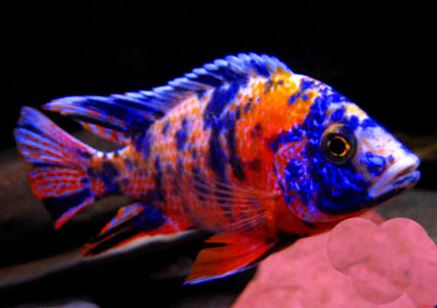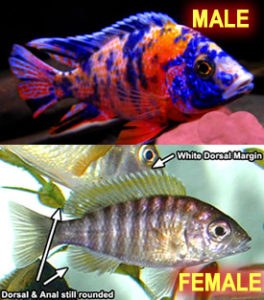
The OB Marble Peacock features a spectacular purple, white, orange and black splotches all over its head and body. It is speculated that the Orange Blotched Peacock Cichlid originated from a cross between an Aulonocara nyassaeand a species of female mbuna also known as the Orange Blossom Peacock. Peacock Cichlids come in a wide variety of colours and patterns (there are 23 Aulonocara species.) They make great additions for a cichlid setup for their bright colours and minimal aggression in the aquarium.
Common Name(s) : Marble Peacock, OB Marble Peacock, (Orange Blotch)

Family : Cichlidae
Genus : Aulonocara
Species : Aulonocara sp. (Man-made hybrid variety)
Maximum Size : 15cm / 6 inches
Lifespan : 10-12 years
Aggression Level : Moderately Aggressive / Slightly Territorial (7/10)
PREFERRED WATER CONDITIONS
Tank Size : 60 Litres +
PH : 7.5 – 8.5
Hardness : Moderate to Hard
Temperature : 23 – 26°C / 73.4–78.8 °F
TANK SET UP
Peacock cichlid inhabit the sandy areas of Lake Malawi, therefore they are not demanding many special needs within an aquarium. Coral Sand with some rockery is best to emulate their natural habitat.
SUITABLE TANK MATES
- Other African cichlids (of similar size)
- Clown Loaches, Featherfin Catfish, Cuckoo Catfish, Bristlenose Catfish, Plecos, Ghost Knives
- They can also sometimes live with barbs, American cichlids, Larger Gourami’s, Eels, Silver & Golden Perch, larger sharks, silver dollar and yabbies.
DIET
Peacocks are omnivores – in the wild they feed on small crustaceans, algae and cichlid fry. In the aquarium provide them a high quality cichlid pellet or flake (this should contain an adequate amount of yellow carotene pigments.) Most of their natural diet is meat based so ensure you also feed peacocks some frozen brine shrimp or frozen bloodworms periodically.
Often when you buy these guys they appear to be more white. The photos included in this article are most certainly the colour-fed varieties. Ask us about what food is best to get these results.
SEXING AND BREEDING
Sexing Peacocks is relatively easy in cichlid terms. Males certainly feature more colour – even from 4-5cm in length. Males are typically more colourful while females are drab in colour (silver and brown). But if in doubt look to the fins of these fish to determine its sex.
Males feature a “pointed” and slightly longer dorsal fin and anal fin. Females will have more rounded fins. The male may have bright egg spots on his anal fin, whilst a small percentage of females will also have egg spots.
Peacock cichlids are maternal mouth brooders; the females take care of the eggs and fry. The average brooding period is 3 weeks after which the female releases her fry.
